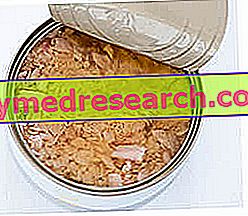Is oil an effective preservative?
Oil is a mildly antiseptic natural preservative agent and particularly useful when used in food preservation. The principle of preservation in oil is to isolate the food (and therefore the substrate) from the atmospheric air, limiting:
- Contamination of volatile bacteria
- The availability of oxygen to aerobic germs.

NB. In addition to the heat treatment of the foods to be preserved in oil, in some cases it may be necessary to use cooking in vinegar and / or in salt water, or drying.
VIDEO RECIPE: AUBERGINES IN OIL MADE IN THE HOUSE
Important tricks and tips to prepare aubergines in oil at home, good but above all safe from a microbiological point of view.
Aubergines in oil - How to store aubergines
X Problems with video playback? Reload from YouTube Go to Video Page Go to Video Recipes Section Watch the video on youtubeBotulism risk
Preservation in oil and botulism
Generality
Botulism is a food poisoning / poisoning due to the ingestion of Clostridium Botulinum (a Gram + bacteria from ANAerobic nature) and especially of its ESOtoxins (toxins produced by its metabolism).
Botulism is the most famous and known food contamination pathology, above all due to the gravity and the often unfavorable pathological course; it is possible to contract botulism especially by eating poorly preserved foods (in particular in oil, vegetable preserves and sausages), sometimes (but not always!) recognizable due to the abundant production of gas and the strong smell of butyric acid (rancid). This peculiarity is induced by the metabolic action of Botulinum which, unlike most bacteria, feeds mainly on lipids.
Unfortunately, the botox spores are very heat resistant.
- The simple boiling (reaching 100 ° C) of the food before immersion in oil is not enough to kill the spores (unless it is prolonged for at least 4/5 hours), indeed, it may even have a counterproductive effect. 5-10 minutes of boiling are however considered sufficient to deactivate botulinum toxins; if the product is consumed immediately after boiling, it can therefore be considered safe, while if it is stored it cannot be assured 100% of its safety.
- To be effective, heat treatment must take place at 121 ° C for at least 3 minutes; similar temperatures can be reached only through the use of autoclaves at the industrial level; according to the guidelines of the Ministry of Health for the correct preparation of food preserves in the domestic environment, the use of the pressure cooker does not guarantee the attainment of pressures, therefore of temperatures, suitable for the destruction of heat-resistant spores.
- Even if the boiling does not guarantee the healthiness of the food, there are other interventions capable of making a preserve safe. For example the conditions of strong acidity (for example tomato puree and vinegar), high concentrations of sugar (jams and jams) and high concentrations of salt (pickled food in brine) do not allow the development of botulinum. In this regard, it is therefore advisable to use a cooking liquid with 10-15% sodium chloride (cooking salt - NaCl) and / or containing more than 2% of acetic acid (through the addition of food vinegar, making the appropriate calculations based on what is reported on the label). In jams, on the other hand, it is important that the sugar percentage reaches at least 50/60%.
- FOR MORE DETAILS: read the dedicated article and learn how to prevent botulinum risk in homemade preserved oil
Symptoms and pathogenicity
Botulinum intoxication (more frequent known as toxinfection, as the bacterium grows with difficulty in the body due to too high temperature), generally occurs 12 to 48 hours after eating food; the early symptoms are nausea, vomiting, diarrhea, state of prostration, blurred vision, dizziness, dry mouth, difficulty swallowing, lesion of the vocal cords and dilated pupils. The botulinum toxin is a neurotoxin that hinders nerve transmission by placing itself between the synapse and the post-synaptic membrane; it follows that, if not treated properly, botulism can result in: glandular paralysis and motor paralysis. For some botulinum strains mortality reaches 60-70%, mainly due to respiratory paralysis of the thoracic muscles and diaphragm.
GUIDELINES OF THE MINISTRY OF HEALTH ON VEGETABLES IN OIL
After having selected, washed and possibly cut them, the vegetables must be blanched for a few minutes in a solution of water and vinegar in equal parts. In this way, in addition to cooking, they will be acidified and preserved in safety. We recommend using wine vinegar with an acidity of 6% or more. If a non-wine vinegar is used, with an acidity of 5% it is advisable not to dilute it in water, but to use it as it is.
The cooking of vegetables must not be prolonged, they must be "al dente" otherwise during the phases of conservation they will completely lose their consistency. If in addition to vegetables we also use spices and aromatic herbs, these too must be blanched in water and vinegar. Once cooked, they must be drained coarsely and left to dry out on a clean, dry cloth, then placed in the container, being careful to fill in all the empty spaces, without crushing them too much.
Once filled, completely cover with the oil and try to remove any air still trapped in the food, using a plastic spatula. Then place a spacer and close the jar. Proceed with pasteurization which will last as long as the container is larger and will also vary depending on the type of product prepared.
If no other indications are given in the recipe, it is advisable to let the preserves stand for at least half a day before placing them in the pantry. They could in fact absorb oil and therefore it may be necessary to top up. It is absolutely essential to consider that, in the case of topping up the oil, the preserves must be re-pasteurized.
In the 10-15 days following the preparation it may be useful to check the preserve stored in the pantry. If signs of alteration appear such as air bubbles rising from the bottom towards the cork, or if the oil becomes opalescent it is a sign that the preserves are altering and may not be suitable for consumption.
It is important to reiterate that, even with the sole suspicion of alteration, the preserve should not be tasted or consumed.
In order to better appreciate its taste, preserves should be consumed at least 2-3 months after preparation. However, if the preparation methods have been carried out correctly, storage times can be very long, even a year and a half.
NON-microbial deterioration
After having dealt with the microbiological aspect, let's clarify the "gustatory" aspect of the heat treatment in oil preservation.
Granted and not allowed that it is possible to sterilize a food without cooking it, at a cellular level the processes of molecular deterioration can occur due to causes independent of bacteria or molds. These are mostly INNOCUE alterations, of an exclusively organoleptic nature and deriving from OWN cellular enzymatic action. Microorganisms, we know, act on foods by exploiting the nutritive principles and producing sometimes toxic molecular waste (toxins); however, what is often not considered is that, in order to be nourished, they exploit the combined action of their digestive enzymes. Well, often similar or even similar catalysts are already present (in decidedly smaller quantities) in eukaryotic cells of animals and plants, therefore also in raw foods. It follows that, even leaving out any contamination, a cellular tissue and / or a nutritional substrate are in any case destined to a proprietary and SPONTANEOUS enzymatic degradation (particularly active in crustaceans, molluscs and fish). These are slower processes than bacterial ones but also extremely influenced by numerous variables: light, oxygen, chemical inhibiting agents (other gases, acids, salts ...) and temperature; in fact, even enzymatic degradation can accelerate or slow down depending on the climate or be thermally inhibited-denatured.
By cooking the foods before preserving them in oil it is possible to inactivate both bacterial / fungal and enzymatic degradation.
NB . In addition to the two aforementioned mechanisms, it is possible to recognize a third one: oxidation and / or peroxidation. These processes are spontaneous and independent of both microbes and food enzymes, and occur more or less intensively based on the presence of oxygen, light and the right temperature.
Types of oil to preserve
As already explained, protection against pathogens and enzymatic degradation occurs above all thanks to the treatments carried out on food BEFORE immersion in oil (possibly supported by a post-packaging heating), since the lipid coverage has above all the function of blocking the aerobic bacteria proliferation.
At this point another problem arises; it is true that oil is useful for food preservation ... but oil is certainly not a food immune to deterioration! It must have well-defined characteristics, including a marked tendency to chemical STABILITY or oxidative resistance.
In particular, extra virgin olive oil (compared to other PURE, NON-ADDED oils) seems to have a set of properties that make it extremely suitable for food preservation. It is also true that extra virgin olive oils are not all the same, as are the different food productions; therefore, the final shelf life of a product in oil undergoes the action of some variables. For example:
- Presence of PRO-preserving molecules, especially antioxidants such as tocopherols (vitamin E) and polyphenols
- Type of technologies used for POST conservation cover: pasteurization and sterilization reduce the oil's antioxidants.
In this regard, the extra virgin olive oil, besides containing an excellent portion of antioxidants, stands out for its excellent thermal stability which favors its integrity even after the sterilization treatment. This aspect makes it particularly suitable for storing pasteurized and / or sterilized food after covering. Furthermore, extra virgin olive oil is characterized by a small portion of polyunsaturated fatty acids compared to monounsaturated fats. The latter, although NOT essential, are characterized by greater oxidative and thermal stability, and contribute to determining the chemical preservative properties of extra virgin olive oil; on the contrary, seed oils (with the necessary differences) do not possess equally excellent characteristics, being much richer in polyunsaturated fatty acids susceptible to oxidation.
NB . It is advisable to carefully choose the type of extra virgin olive oil to be used based on the type of food stored. For fatty foods with a strong taste, it is advisable to use an oil that is tastefully weak but rich in antioxidants, while for vegetables or other foods with a less pronounced flavor it would be advisable to choose a strong oil and possibly a bitter and spicy aftertaste.
Bibliography:
- Practical manual of hygiene - U. Sasso - Piccin - pag 139
- Extra virgin olive oil - V. Sciancalepore - Hoepli



